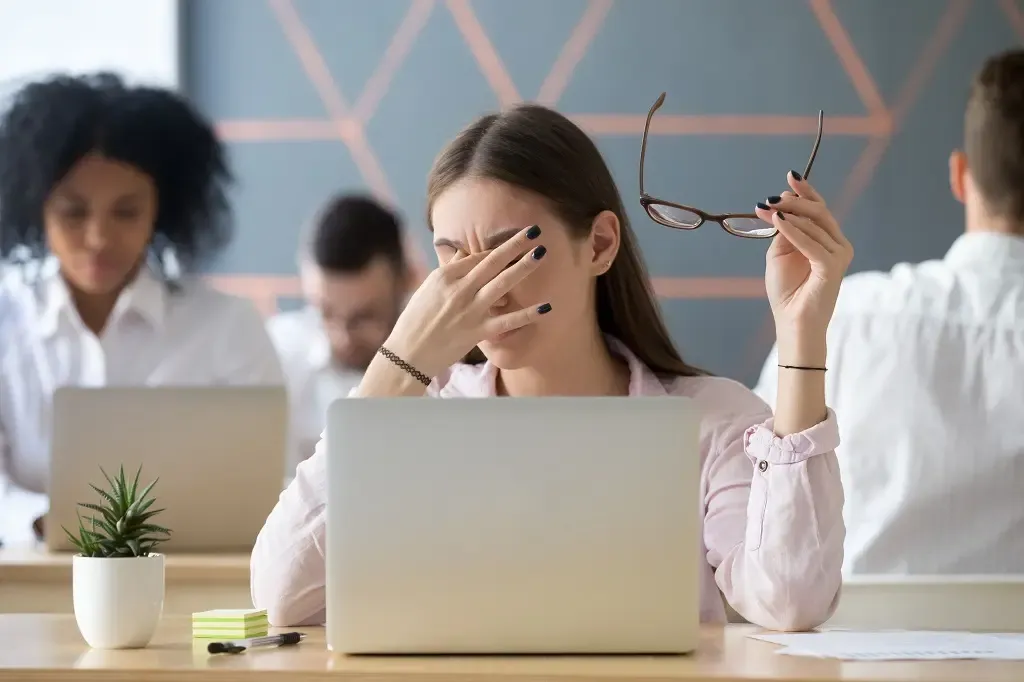Impact of Digital Screens on Eyes
How Digital Screens Truly Impact Your Eyes
FSDAVCFEBFEVSDDVFSD
FSDAVCFEBFEVSDDVFSD
FSDAVCFEBFEVSDDVFSD
Managing Screen Time
How much do you think about the impact of daily screen use on your eyes? In today's digital age, screens are an integral part of our lives, computers, smartphones, tablets, and televisions dominate our routines. This constant exposure raises significant concerns about eye health.
Many people report symptoms like dry eyes, headaches, and blurred vision after extended screen time. But what are the hidden effects of prolonged screen exposure on our vision? Understanding these impacts is crucial for maintaining good eye health in our screen-centric world. Let's look into how digital screens affect our eyes and what steps can be taken to mitigate these effects.
How much do you think about the impact of daily screen use on your eyes? In today's digital age, screens are an integral part of our lives, computers, smartphones, tablets, and televisions dominate our routines. This constant exposure raises significant concerns about eye health.

Many people report symptoms like dry eyes, headaches, and blurred vision after extended screen time. But what are the hidden effects of prolonged screen exposure on our vision? Understanding these impacts is crucial for maintaining good eye health in our screen-centric world. Let's look into how digital screens affect our eyes and what steps can be taken to mitigate these effects.

Effects of Digital Screens on Eyes
Extended use of digital screens can lead to a condition known as digital eye strain, which encompasses symptoms such as dry eyes, blurred vision, headaches, and neck and shoulder pain. The increasing amount of screen time in our daily lives significantly impacts our eye health. One of the major culprits is the blue light emitted by screens. This blue light can disrupt sleep patterns and has potential long-term effects on eye health, making digital device eye care more critical than ever.
Staring at screens for long periods reduces our blink rate, leading to dry eyes. This reduction in blinking means our eyes are not being lubricated as they should be, which is a key factor in computer vision syndrome. Focusing on close-up tasks for extended durations also strains the eye muscles, contributing to the development of myopia or nearsightedness, especially in children and adolescents.
To mitigate these effects, incorporating screen time guidelines and taking regular breaks can provide significant eye strain relief. Adjusting screen settings to reduce blue light exposure and using digital eye protection, like blue light filtering glasses, are effective eye health tips.
Common Symptoms of Digital Eye Strain
Moving next to another significant advantage, Ortho-K offers a non-surgical solution to vision correction, setting it apart from procedures like LASIK. This non-invasive approach is suitable for both adults and children, making it a versatile option for families. Ortho-K does not involve any surgical risks and is completely reversible, providing a safe alternative for those hesitant about permanent surgical interventions.
This attribute ensures that individuals can manage their myopia or other refractive errors without the potential complications associated with surgery.
Moreover, Ortho-K is an excellent choice for children and teenagers whose eyes are still developing. Surgical options like LASIK are typically not recommended for younger individuals, as their vision can continue to change throughout their adolescence. Ortho-K, on the other hand, is perfectly suited for this age group, offering a safe and effective way to correct vision without impacting the natural growth and development of the eyes. Parents can feel confident in choosing Ortho-K for their children, knowing it provides a flexible and non-permanent solution that can adapt to their changing vision needs.
Furthermore, the non-surgical nature of Ortho-K allows for adjustments and modifications over time. As a person's vision changes, the lenses can be updated to continue providing optimal correction.
4: Reversible Treatment

Addressing digital eye strain effectively involves a combination of strategies that can help mitigate its effects and maintain eye health. One of the simplest and most effective methods is following the 20-20-20 rule, which encourages taking a 20-second break to look at something 20 feet away every 20 minutes. This practice helps relax the eye muscles and reduce strain from prolonged screen time, offering a quick and easy way to prevent eye fatigue.
Proper lighting and screen position in your workspace can also significantly reduce eye strain. Ensuring that your screen is at eye level and about an arm's length away can prevent you from straining your neck and eyes. Additionally, adjusting screen brightness and contrast to comfortable levels can make a big difference. Ensuring proper lighting in the room, such as using soft, indirect light and reducing glare from windows or overhead lights, can also help.
Addressing digital eye strain effectively involves a combination of strategies that can help mitigate its effects and maintain eye health. One of the simplest and most effective methods is following the 20-20-20 rule, which encourages taking a 20-second break to look at something 20 feet away every 20 minutes. This practice helps relax the eye muscles and reduce strain from prolonged screen time, offering a quick and easy way to prevent eye fatigue.
Proper lighting and screen position in your workspace can also significantly reduce eye strain. Ensuring that your screen is at eye level and about an arm's length away can prevent you from straining your neck and eyes. Additionally, adjusting screen brightness and contrast to comfortable levels can make a big difference. Ensuring proper lighting in the room, such as using soft, indirect light and reducing glare from windows or overhead lights, can also help.

Furthermore, incorporating the use of lubricating eye drops can alleviate dryness and discomfort, which are common symptoms of digital eye strain. Taking regular breaks from screen use and practicing good eye hygiene are essential steps in supporting long-term eye health. Implementing these strategies can create a more comfortable and eye-friendly environment, promoting overall well-being and reducing the negative impacts of extensive screen time.
Avoiding harsh overhead lighting and glare on your screen is important. Positioning your screen about 20 to 30 inches away from your eyes and slightly below eye level can help maintain a comfortable viewing angle. Taking regular breaks from screens is crucial for digital eye protection. During these breaks, try eye exercises such as focusing on distant objects, rolling your eyes in different directions, and blinking frequently to keep your eyes moist and relaxed.
Furthermore, incorporating the use of lubricating eye drops can alleviate dryness and discomfort, which are common symptoms of digital eye strain. Taking regular breaks from screen use and practicing good eye hygiene are essential steps in supporting long-term eye health. Implementing these strategies can create a more comfortable and eye-friendly environment, promoting overall well-being and reducing the negative impacts of extensive screen time.
Avoiding harsh overhead lighting and glare on your screen is important. Positioning your screen about 20 to 30 inches away from your eyes and slightly below eye level can help maintain a comfortable viewing angle. Taking regular breaks from screens is crucial for digital eye protection. During these breaks, try eye exercises such as focusing on distant objects, rolling your eyes in different directions, and blinking frequently to keep your eyes moist and relaxed.
Adjusting Digital Habits for Better Eye Health
To maintain optimal eye health, it’s important to adjust digital habits, especially in an age where screen use is ubiquitous. Balancing screen time with other activities is a key step. Reducing screen exposure and encouraging outdoor activities can help alleviate digital eye strain and contribute to overall well-being.
Setting limits on screen usage, particularly for children and teens, is also important. Establishing screen-free times, such as during meals or before bedtime, can help reduce the strain on the eyes and improve sleep quality, considering the negative impact of blue light on sleep patterns.
Creating a comfortable and eye-friendly environment is another effective strategy. This includes using proper lighting, adjusting screen settings to reduce glare, and positioning screens at an appropriate distance and height. Using features like night mode or blue light filters can also minimize the adverse effects of blue light exposure.
When to Seek Professional Help?
While good habits and eye health tips can reduce digital eye strain, professional help is sometimes necessary. Persistent symptoms like headaches, blurred vision, or severe discomfort, despite following screen time guidelines and lifestyle adjustments, indicate it may be time to consult an eye care professional.
Eye care professionals can provide comprehensive eye exams to identify underlying issues that may not be apparent through self-assessment. These exams differentiate between digital eye strain and other eye conditions, allowing for timely intervention. Early detection prevents serious complications and ensures appropriate treatment.
While good habits and eye health tips can reduce digital eye strain, professional help is sometimes necessary. Persistent symptoms like headaches, blurred vision, or severe discomfort, despite following screen time guidelines and lifestyle adjustments, indicate it may be time to consult an eye care professional.
Eye care professionals can provide comprehensive eye exams to identify underlying issues that may not be apparent through self-assessment. These exams differentiate between digital eye strain and other eye conditions, allowing for timely intervention. Early detection prevents serious complications and ensures appropriate treatment.
Conclusion
To protect your eye health from the effects of digital screens, it's essential to understand digital eye strain and take proactive measures. Utilizing the latest myopia treatments like orthokeratology (Ortho-K), multifocal contact lenses, and atropine drops can significantly improve vision care.
Implementing eye health tips such as the 20-20-20 rule, proper lighting, and regular breaks can reduce strain. Regular eye exams are important for early detection and management. Schedule an appointment with an eye care professional to stay updated on myopia treatment advancements and maintain optimal vision health. Call now to book your consultation and protect your eyes.

Contact Info
Hours of Operation
Mon - Fri | 9:00 AM - 5:00 PM
Sat - Sun | Closed
Holiday Hours: We are closed for the following holidays: New Years Day, Memorial Day, Independence Day, Labor Day, Thanksgiving Day, Christmas Day
© 2025 Kleinwood Vision. All rights Reserved.


